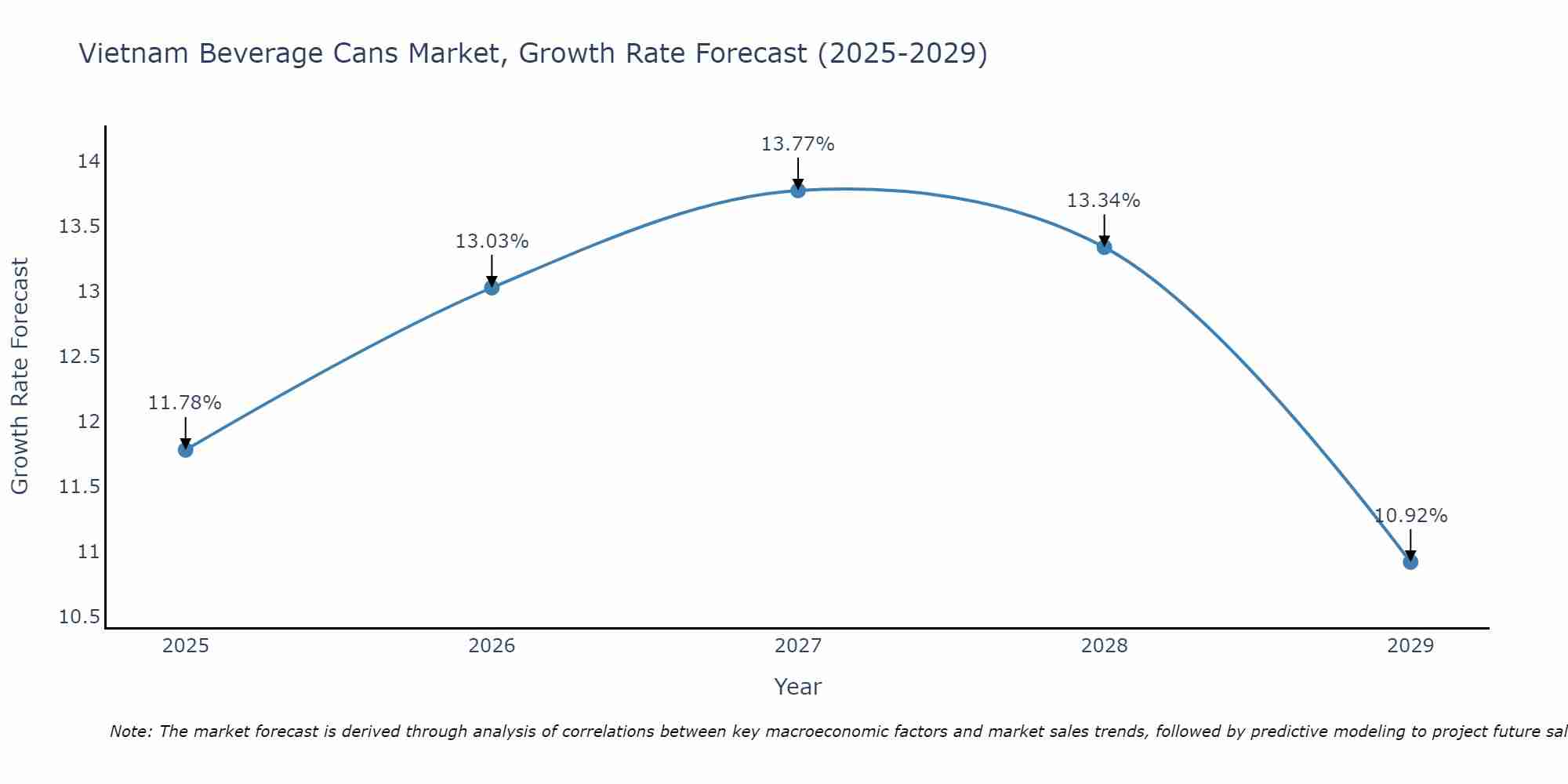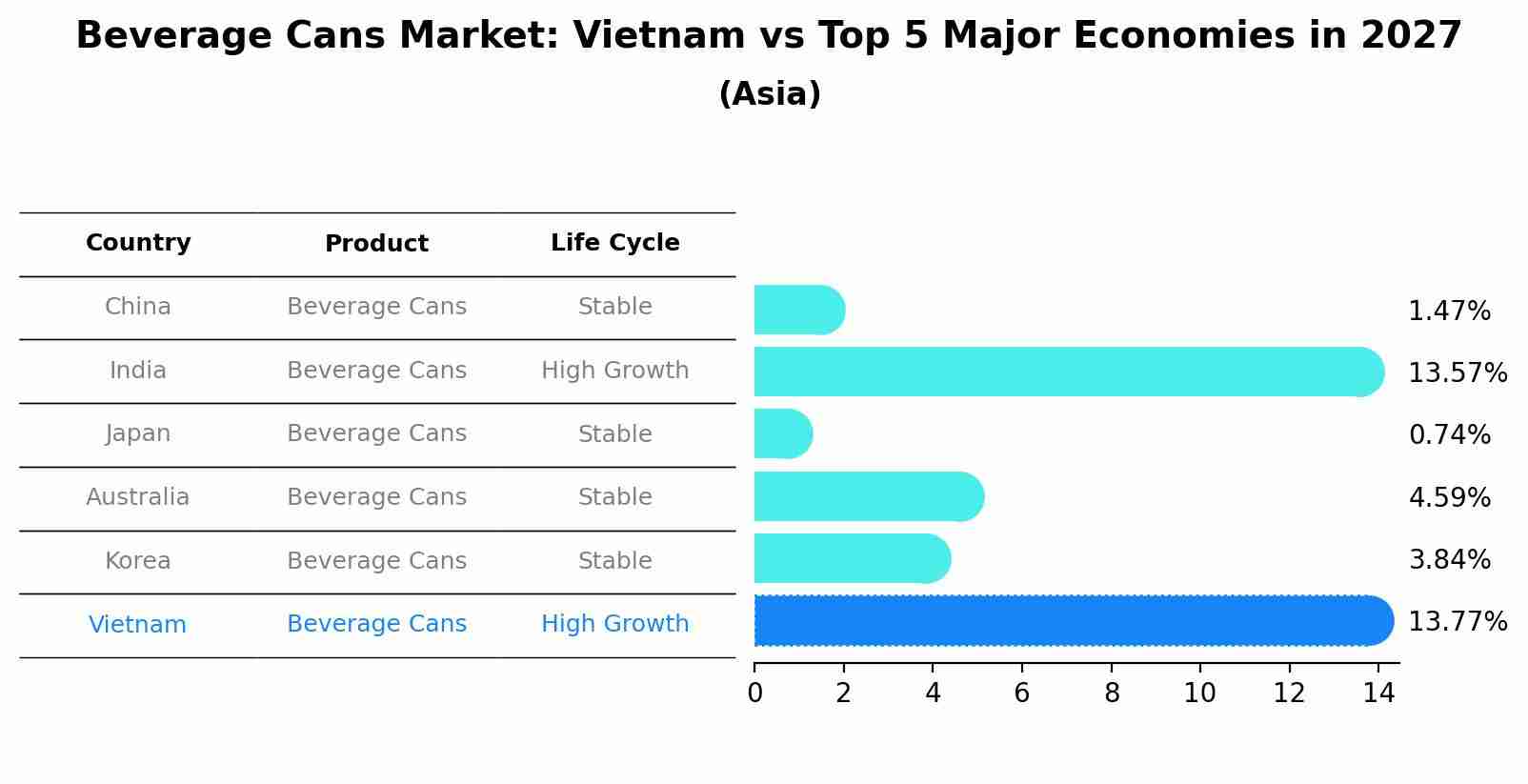Vietnam Beverage Cans Market (2025-2031) Outlook | Analysis, Revenue, Share, Companies, Size, Growth, Industry, Trends, Forecast & Value
Market Forecast By Product Type (Aluminium, Steel), By Application (Carbonated Water, Flavored Water, Still Water, Functional Water) And Competitive Landscape
| Product Code: ETC189942 | Publication Date: May 2022 | Updated Date: Aug 2025 | Product Type: Market Research Report | |
| Publisher: 6Wresearch | Author: Ravi Bhandari | No. of Pages: 60 | No. of Figures: 40 | No. of Tables: 7 |
Vietnam Beverage Cans Market Size Growth Rate
The Vietnam Beverage Cans Market is projected to witness mixed growth rate patterns during 2025 to 2029. Starting at 11.78% in 2025, the market peaks at 13.77% in 2027, and settles at 10.92% by 2029.

Beverage Cans Market: Vietnam vs Top 5 Major Economies in 2027 (Asia)
By 2027, Vietnam's Beverage Cans market is forecasted to achieve a high growth rate of 13.77%, with China leading the Asia region, followed by India, Japan, Australia and South Korea.

Vietnam Beverage Cans Market Overiew
The Vietnam Beverage Cans market is integral to the thriving beverage industry in the country. With the rising consumption of canned beverages, market players are investing in advanced manufacturing processes and materials to meet the demand for lightweight, durable, and visually appealing cans. The market is influenced by consumer preferences, brand differentiation, and sustainability considerations, driving continuous innovation in beverage can packaging.
Drivers of the Market
The Vietnam beverage cans market is on a trajectory of steady growth, driven by the flourishing beverage industry and shifting consumer preferences towards on-the-go and convenient packaging solutions. As the demand for carbonated drinks, energy drinks, and ready-to-drink beverages rises, beverage cans have emerged as a preferred choice for manufacturers. The lightweight and recyclable nature of cans align with sustainability trends, contributing to their popularity. Additionally, the convenience factor, coupled with innovative packaging designs, is further propelling the beverage cans market. As manufacturers prioritize eco-friendly packaging and consumers seek convenience, the Vietnam beverage cans market is poised for sustained expansion.
Challenges of the Market
In the beverage cans market, sustainability and recycling present significant challenges. Encouraging the adoption of recyclable materials and promoting responsible disposal practices are crucial for the industry`s long-term success. Overcoming consumer inertia and ensuring that recycling infrastructure is in place across the country are key challenges that need to be addressed.
COVID 19 Impact on the Market
The Vietnam Beverage Cans Market experienced notable shifts in consumer preferences and market dynamics during the COVID-19 pandemic. The closure of bars and restaurants, coupled with restrictions on outdoor activities, impacted the demand for canned beverages. However, the surge in at-home consumption led to increased sales through retail channels. Beverage can manufacturers faced challenges related to supply chain disruptions and raw material shortages. The market is now witnessing a rebound as restrictions ease, and the food and beverage industry adapts to the new normal. Sustainability concerns and the demand for lightweight packaging are expected to shape the future of the beverage cans market in Vietnam.
Key Players in the Market
Key players dominating the Vietnam Beverage Cans market include Ball Corporation, Crown Holdings, and Toyo Seikan Group. Renowned for their cutting-edge technology and commitment to sustainability, these companies play a crucial role in meeting the packaging demands of Vietnam`s thriving beverage industry.
Key Highlights of the Report:
- Vietnam Beverage Cans Market Outlook
- Market Size of Vietnam Beverage Cans Market, 2024
- Forecast of Vietnam Beverage Cans Market, 2031
- Historical Data and Forecast of Vietnam Beverage Cans Revenues & Volume for the Period 2021-2031
- Vietnam Beverage Cans Market Trend Evolution
- Vietnam Beverage Cans Market Drivers and Challenges
- Vietnam Beverage Cans Price Trends
- Vietnam Beverage Cans Porter's Five Forces
- Vietnam Beverage Cans Industry Life Cycle
- Historical Data and Forecast of Vietnam Beverage Cans Market Revenues & Volume By Product Type for the Period 2021-2031
- Historical Data and Forecast of Vietnam Beverage Cans Market Revenues & Volume By Aluminium for the Period 2021-2031
- Historical Data and Forecast of Vietnam Beverage Cans Market Revenues & Volume By Steel for the Period 2021-2031
- Historical Data and Forecast of Vietnam Beverage Cans Market Revenues & Volume By Application for the Period 2021-2031
- Historical Data and Forecast of Vietnam Beverage Cans Market Revenues & Volume By Carbonated Water for the Period 2021-2031
- Historical Data and Forecast of Vietnam Beverage Cans Market Revenues & Volume By Flavored Water for the Period 2021-2031
- Historical Data and Forecast of Vietnam Beverage Cans Market Revenues & Volume By Still Water for the Period 2021-2031
- Historical Data and Forecast of Vietnam Beverage Cans Market Revenues & Volume By Functional Water for the Period 2021-2031
- Vietnam Beverage Cans Import Export Trade Statistics
- Market Opportunity Assessment By Product Type
- Market Opportunity Assessment By Application
- Vietnam Beverage Cans Top Companies Market Share
- Vietnam Beverage Cans Competitive Benchmarking By Technical and Operational Parameters
- Vietnam Beverage Cans Company Profiles
- Vietnam Beverage Cans Key Strategic Recommendations
Frequently Asked Questions About the Market Study (FAQs):
| 1 Executive Summary |
| 2 Introduction |
| 2.1 Key Highlights of the Report |
| 2.2 Report Description |
| 2.3 Market Scope & Segmentation |
| 2.4 Research Methodology |
| 2.5 Assumptions |
| 3 Vietnam Beverage Cans Market Overview |
| 3.1 Vietnam Country Macro Economic Indicators |
| 3.2 Vietnam Beverage Cans Market Revenues & Volume, 2021 & 2031F |
| 3.3 Vietnam Beverage Cans Market - Industry Life Cycle |
| 3.4 Vietnam Beverage Cans Market - Porter's Five Forces |
| 3.5 Vietnam Beverage Cans Market Revenues & Volume Share, By Product Type, 2021 & 2031F |
| 3.6 Vietnam Beverage Cans Market Revenues & Volume Share, By Application, 2021 & 2031F |
| 4 Vietnam Beverage Cans Market Dynamics |
| 4.1 Impact Analysis |
| 4.2 Market Drivers |
| 4.2.1 Increasing urbanization leading to a rise in on-the-go consumption habits |
| 4.2.2 Growing disposable income of the middle class population |
| 4.2.3 Changing lifestyle preferences towards convenience and sustainability |
| 4.3 Market Restraints |
| 4.3.1 Fluctuating raw material prices impacting production costs |
| 4.3.2 Competition from alternative packaging materials such as plastic bottles |
| 4.3.3 Regulatory challenges related to recycling and waste management |
| 5 Vietnam Beverage Cans Market Trends |
| 6 Vietnam Beverage Cans Market, By Types |
| 6.1 Vietnam Beverage Cans Market, By Product Type |
| 6.1.1 Overview and Analysis |
| 6.1.2 Vietnam Beverage Cans Market Revenues & Volume, By Product Type, 2021-2031F |
| 6.1.3 Vietnam Beverage Cans Market Revenues & Volume, By Aluminium, 2021-2031F |
| 6.1.4 Vietnam Beverage Cans Market Revenues & Volume, By Steel, 2021-2031F |
| 6.2 Vietnam Beverage Cans Market, By Application |
| 6.2.1 Overview and Analysis |
| 6.2.2 Vietnam Beverage Cans Market Revenues & Volume, By Carbonated Water, 2021-2031F |
| 6.2.3 Vietnam Beverage Cans Market Revenues & Volume, By Flavored Water, 2021-2031F |
| 6.2.4 Vietnam Beverage Cans Market Revenues & Volume, By Still Water, 2021-2031F |
| 6.2.5 Vietnam Beverage Cans Market Revenues & Volume, By Functional Water, 2021-2031F |
| 7 Vietnam Beverage Cans Market Import-Export Trade Statistics |
| 7.1 Vietnam Beverage Cans Market Export to Major Countries |
| 7.2 Vietnam Beverage Cans Market Imports from Major Countries |
| 8 Vietnam Beverage Cans Market Key Performance Indicators |
8.1 Sustainability metrics like recycled content percentage in beverage cans |
8.2 Consumer perception surveys on the convenience of beverage cans |
8.3 Adoption rate of innovative can designs or technologies in the market |
| 9 Vietnam Beverage Cans Market - Opportunity Assessment |
| 9.1 Vietnam Beverage Cans Market Opportunity Assessment, By Product Type, 2021 & 2031F |
| 9.2 Vietnam Beverage Cans Market Opportunity Assessment, By Application, 2021 & 2031F |
| 10 Vietnam Beverage Cans Market - Competitive Landscape |
| 10.1 Vietnam Beverage Cans Market Revenue Share, By Companies, 2024 |
| 10.2 Vietnam Beverage Cans Market Competitive Benchmarking, By Operating and Technical Parameters |
| 11 Company Profiles |
| 12 Recommendations |
| 13 Disclaimer |
- Single User License$ 1,995
- Department License$ 2,400
- Site License$ 3,120
- Global License$ 3,795
Search
Thought Leadership and Analyst Meet
Our Clients
Related Reports
- Afghanistan Apparel Market (2026-2032) | Growth, Outlook, Industry, Segmentation, Forecast, Size, Companies, Trends, Value, Share, Analysis & Revenue
- Canada Oil and Gas Market (2026-2032) | Share, Segmentation, Value, Industry, Trends, Forecast, Analysis, Size & Revenue, Growth, Competitive Landscape, Outlook, Companies
- Germany Breakfast Food Market (2026-2032) | Industry, Share, Growth, Size, Companies, Value, Analysis, Revenue, Trends, Forecast & Outlook
- Australia Briquette Market (2025-2031) | Growth, Size, Revenue, Forecast, Analysis, Trends, Value, Share, Industry & Companies
- Vietnam System Integrator Market (2025-2031) | Size, Companies, Analysis, Industry, Value, Forecast, Growth, Trends, Revenue & Share
- ASEAN and Thailand Brain Health Supplements Market (2025-2031) | Strategy, Consumer Insights, Analysis, Investment Trends, Opportunities, Growth, Size, Share, Industry, Revenue, Segments, Value, Segmentation, Supply, Forecast, Restraints, Outlook, Competition, Drivers, Trends, Demand, Pricing Analysis, Competitive, Strategic Insights, Companies, Challenges
- ASEAN Bearings Market (2025-2031) | Strategy, Consumer Insights, Analysis, Investment Trends, Opportunities, Growth, Size, Share, Industry, Revenue, Segments, Value, Segmentation, Supply, Forecast, Restraints, Outlook, Competition, Drivers, Trends, Demand, Pricing Analysis, Competitive, Strategic Insights, Companies, Challenges
- Europe Flooring Market (2025-2031) | Outlook, Share, Industry, Trends, Forecast, Companies, Revenue, Size, Analysis, Growth & Value
- Saudi Arabia Manlift Market (2025-2031) | Outlook, Size, Growth, Trends, Companies, Industry, Revenue, Value, Share, Forecast & Analysis
- Uganda Excavator, Crane, and Wheel Loaders Market (2025-2031) | Strategy, Consumer Insights, Analysis, Investment Trends, Opportunities, Growth, Size, Share, Industry, Revenue, Segments, Value, Segmentation, Supply, Forecast, Restraints, Outlook, Competition, Drivers, Trends, Demand, Pricing Analysis, Competitive, Strategic Insights, Companies, Challenges
Industry Events and Analyst Meet
Whitepaper
- Middle East & Africa Commercial Security Market Click here to view more.
- Middle East & Africa Fire Safety Systems & Equipment Market Click here to view more.
- GCC Drone Market Click here to view more.
- Middle East Lighting Fixture Market Click here to view more.
- GCC Physical & Perimeter Security Market Click here to view more.
6WResearch In News
- Doha a strategic location for EV manufacturing hub: IPA Qatar
- Demand for luxury TVs surging in the GCC, says Samsung
- Empowering Growth: The Thriving Journey of Bangladesh’s Cable Industry
- Demand for luxury TVs surging in the GCC, says Samsung
- Video call with a traditional healer? Once unthinkable, it’s now common in South Africa
- Intelligent Buildings To Smooth GCC’s Path To Net Zero


















